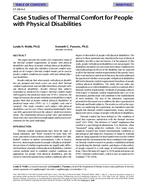
SF-98-04-2 — Case Studies of Thermal Comfort for People with Physical Disabilities
- Comments Off on SF-98-04-2 — Case Studies of Thermal Comfort for People with Physical Disabilities
- ASHRAE
This paper presents the results of a comparative study of the thermal comfort requirements of people with physical disabilities and those of people without physical disabilities. In addition, the study also identifies if present comfort standards set by Fanger’s thermal comfort model can be used to predict comfort conditions for people with and without physical disabilities. Results indicate that when people with physical disabilities are grouped and mean scores are used, their thermal comfort requirements may not differ from those of people without physical disabilities. Results showed that subjects responded as predicted by Fanger’s thermal comfort model with regard to the predicted mean vote (PMV). However, the range of responses for people with physical disabilities is much greater than that of people without physical disabilities at predicted mean votes (PMV) of -1.5 (slightly cool) and 0 (neutral). This study considers each subject with physical disabilities case by case. When considered individually, there was little agreement between the subjects’ preferred environments. The relationship between actual votes and predicted mean votes also varied between individuals and between environments for the same individual.
Units: SI
Citation: Symposium, ASHRAE Transactions, 1998, Vol 104, pt. 1A, San Francisco
Product Details
- Published:
- 1998
- Number of Pages:
- 13
- File Size:
- 1 file , 240 KB
- Product Code(s):
- D-7848

